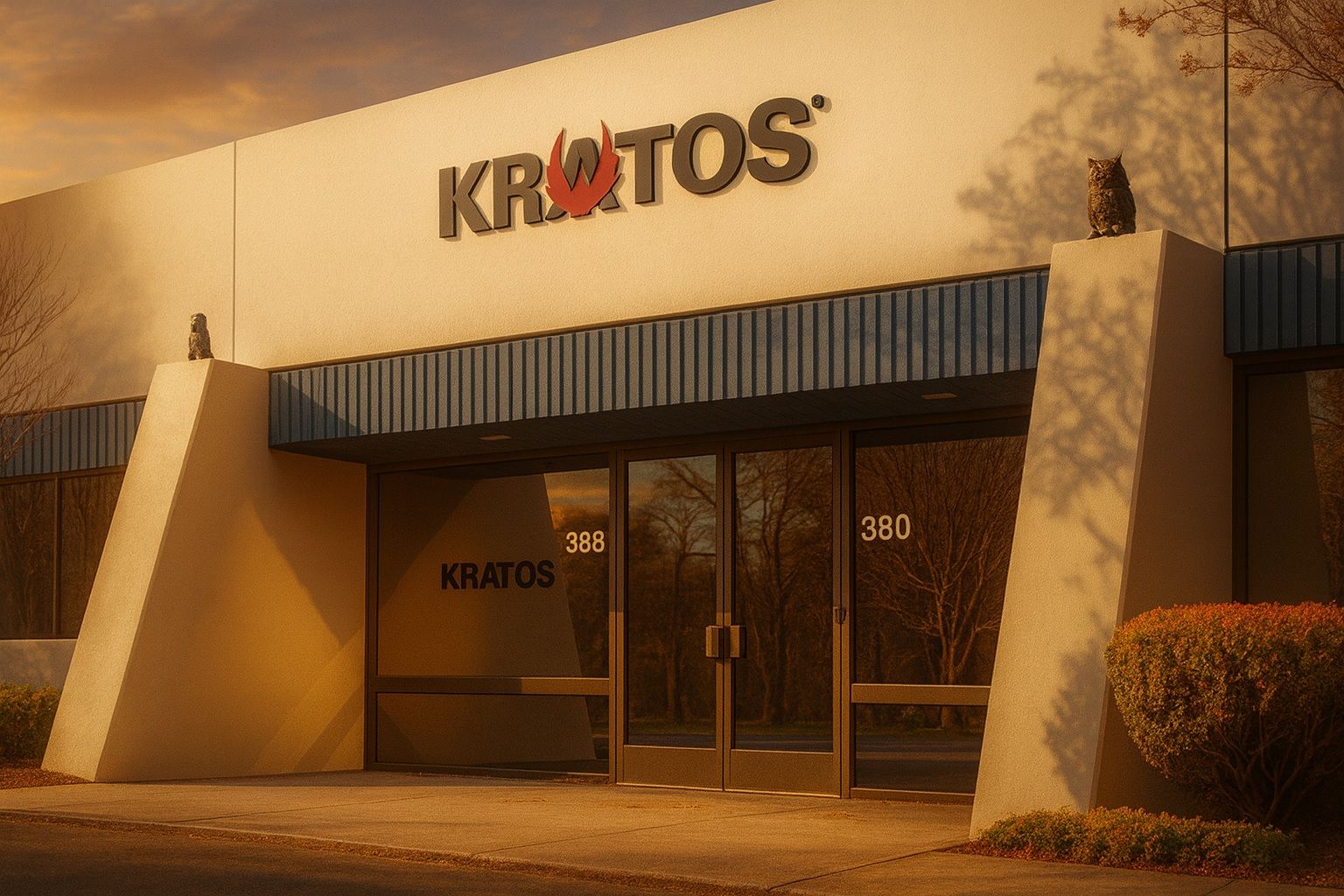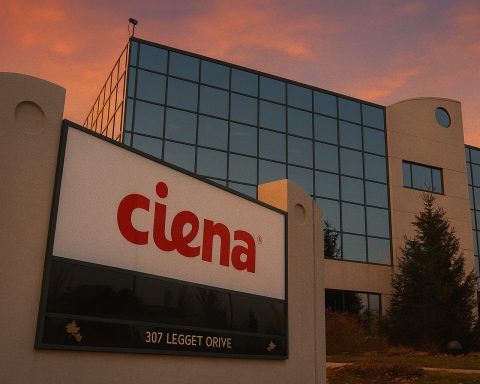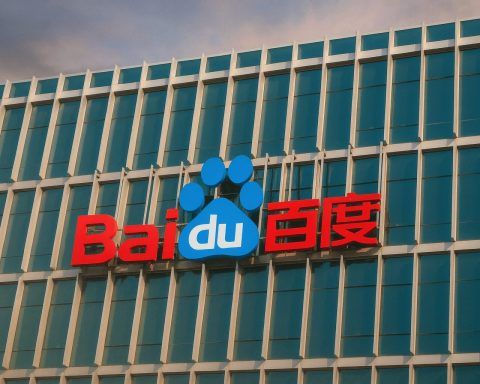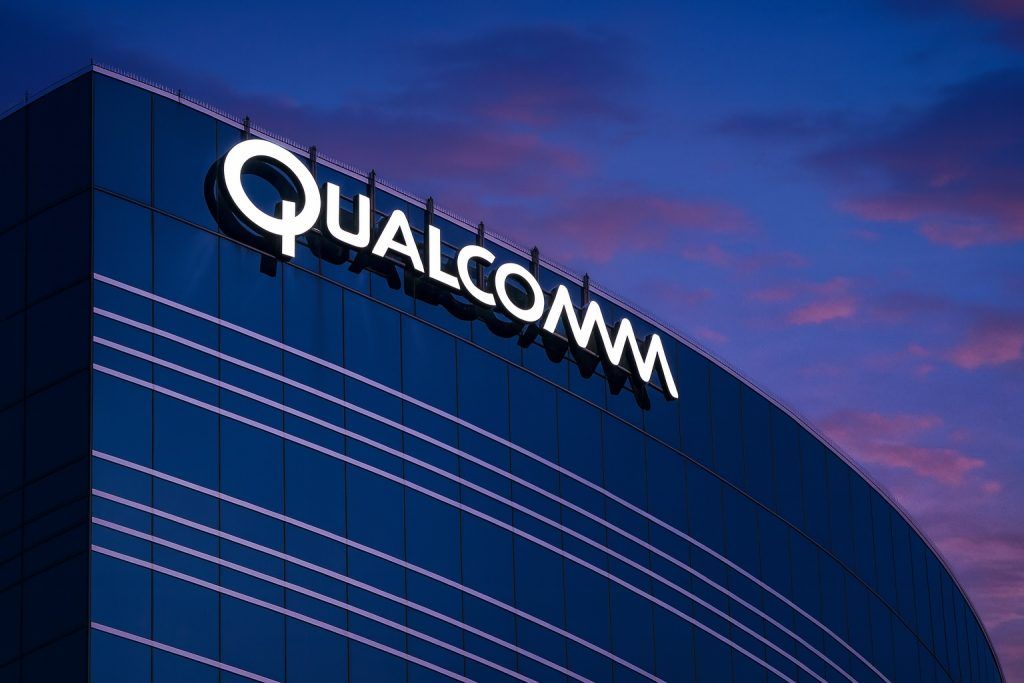- Ticker & Market: NASDAQ: KTOS (Kratos Defense & Security Solutions, Inc.) [1].
- Market Cap: ≈$16.6 billion [2].
- YTD Return: +274% (Jan–Oct 2025) [3].
- 52‑Week Range: $22.69–$112.57 [4].
- P/E Ratio (ttm): ≈985× [5], reflecting an unusually high valuation.
- Employees: ~4,000 worldwide [6].
- Business: Design and production of defense systems emphasizing affordability. Kratos focuses on unmanned aerial systems (drones), hypersonic and propulsion systems, satellite/space ground systems, C5ISR and microwaves [7] [8]. The company touts “affordability as a technology,” aiming for rapid, low-cost development and production of defense products [9].
- Customers: Primarily the U.S. Department of Defense (Air Force, Navy, Space Force, DARPA) and allied militaries. In Sept 2025 Kratos joined the S&P MidCap 400 index [10], reflecting its growth and defense-sector prominence.
- Key Products: Jet-powered target drones (e.g. full-scale aerial targets), tactical UAVs (e.g. XQ-58 Valkyrie designs), hypersonic test vehicles (Erinyes and Dark Fury) [11] [12], microwave electronics for missiles and radar, and virtualized satellite ground stations (OpenSpace platform) [13].
- Recent Contracts: Notable wins include a Phase 1 contract (potentially ~$175 M) to modernize the U.S. Navy’s AN/SPY-1 Aegis radar system [14] [15], and a 5‑year deal as exclusive U.S. manufacturer for Elroy Air’s Chaparral cargo drone [16]. In Sept 2025 Kratos was selected for the S&P MidCap 400 (from SmallCap) [17].
Stock Performance and Valuation
Kratos stock has exploded higher in 2025. After trading around $22 in late 2024, KTOS surged to a 52-week high ~$112.57 in early Oct 2025 [18]. On Oct 9, 2025 the stock closed around $98.55, down about 6.7% from the prior day’s ~$105.67 [19] (after a downgrade by B. Riley) – yet still vastly above last year’s lows. The YTD gain (~+274%) far outpaces the rest of the defense sector [20].
Recent Trading: KTOS saw heavy volume on Oct 8–9 (≈8.1 M shares vs ~5.7 M avg [21]) as analysts reacted to news. B. Riley cut its rating to Neutral (raising its price target to $105 from $72) on Oct 9 [22], triggering a pullback. However, other firms have raised targets (e.g. JMP Securities to $105, Canaccord to $120 [23] [24]). As of Oct 10 (pre-market), KTOS trades in the low $90s – up off the Oct 9 low but below the late-September peak.
Valuation: The stock’s price/earnings ratio is extraordinarily high (~1000×) [25]. Analysts note that KTOS trades at a “lofty valuation” and may see a pullback before further gains [26]. Nevertheless, many analysts remain optimistic due to Kratos’s growth and defense tailwinds. MarketBeat reports a consensus “Moderate Buy” rating, with 12 Buy and 1 Strong Buy versus 4 Holds [27], even though the average 12‑month price target (~$69) lags the recent price [28].
Business Model and Technologies
Kratos markets itself as a “technology company in defense and national security” focused on innovation and affordability [29] [30]. In practice, it divides its business into segments like Unmanned Systems (KUS) and Government Solutions (KGS). It funds internal R&D to rapidly develop new products. For example, Kratos develops high-performance jet drones and targets (XQ-58A Valkyrie, Tactical Firejet), affordable microwave and missile sub-systems (e.g. RF components, rocket propulsion), and virtualized space-ground systems (OpenSpace satellite ground segment) [31] [32]. CEO DeMarco emphasizes Kratos’s role as a “disruptive change agent” using proven tech to cut cost and schedule [33].
Technological Edge: Kratos has advanced expertise in new defense niches. It is pushing virtualized ground networks for space and satcom: its OpenSpace platform “virtualizes the entire ground signal chain” using software-defined networking and cloud tech [34]. In hypersonics, Kratos has developed the Erinyes and Dark Fury test vehicles [35]. In unmanned systems, it touts delivery of “thousands of uncrewed aircraft” and ability to scale production [36] [37]. An Elroy Air executive noted “Kratos is an established and trusted producer of military UAS” with a focus on affordability and volume production [38]. TS2.tech reports that international demand is rising: Kratos saw “increased inquiries from allies in Europe and Asia, potentially boosting its backlog” for tactical UAVs [39].
Contracts & Agreements: Kratos has secured a variety of military contracts. In addition to the AN/SPY-1 radar work [40], Kratos earlier won DoD deals for target drones (BQM-167, Firejet), rocket motors (Oriole, Zeus) and space ground systems (Space Development Agency programs) [41] [42]. Recent wins include completing the SDA Advanced Fire Control ground-integration design review [43], and a plan to build Chaparral VTOL cargo drones under a 5-year pact with Elroy Air [44]. These illustrate a mix of sustainment, new-production, and partnership programs.
Recent News (Oct 2025)
- Navy Radar Contract: On Oct 7, 2025 Kratos announced Phase 1 of the “Anaconda” AN/SPY-1 radar sustainment program. The initial contract is ~ $33 M (Phase 1), with a total potential ceiling of $175 M over multiple phases [45] [46]. CEO Eric DeMarco said this contract could generate “multi-decade value for both the US Navy and Kratos” [47]. This deal (updating shipboard radars used on Aegis destroyers/cruisers) has driven recent stock enthusiasm.
- Elroy Air Manufacturing: In late Sept 2025 Kratos was named exclusive U.S. manufacturer for Elroy Air’s Chaparral hybrid-electric VTOL cargo drone [48]. Under a five-year agreement, Kratos will build Chaparrals (first unit due 2026) using its expanded California and Oklahoma production facilities [49] [50]. This partnership highlights Kratos’s growing role in the drone supply chain and its ability to scale high-volume UAV production [51] [52].
- Index Addition: On Sept 22 Kratos announced it will join the S&P MidCap 400 index [53]. The press release hailed the move as validation of Kratos’s growth and leadership in unmanned/hypersonics/space. CEO DeMarco said inclusion “reflects both our financial growth and confidence in Kratos’ strategy” [54].
- Analyst Ratings: In early Oct, several analysts adjusted their views. Canaccord Genuity and JMP Securities raised their targets (to $120 and $105, respectively) citing the Navy contract and growth prospects [55] [56]. Conversely, B. Riley cut its rating to Neutral (target $105) on Oct 9 [57], and Morgan Stanley in Aug maintained a Hold at only ~$62 [58]. MarketBeat on Oct 10 reports a “Moderate Buy” consensus among 17 analysts [59].
- Insider Activity: Several insiders have sold stock recently. In late Sept the company’s Vice President Maria Cervantes sold ~$437k of shares (avg $69.80) [60]; on Oct 1 CFO Deanna Lund sold 5,000 shares (~$460k at ~$92) [61]. Insider ownership is now just 2.37% [62] [63], which some investors watch as a bearish signal.
Expert Commentary and Analysis
Financial and defense analysts offer mixed takes on Kratos: bullish on new defense funding, cautious on valuation. A Motley Fool report noted analysts “are increasingly optimistic that Kratos stock can soar higher” but warned its 1057×-earnings ratio makes it richly priced [64]. The Fool highlighted JMP’s upgrade to $105 (outperform) on Oct 2, citing Kratos’s expansion in unmanned systems, space, and satellites [65]. Similarly, Canaccord’s Oct 9 note upped its price target to $120 (from $74) after the Navy contract, noting it supports ballistic missile defense [66].
MarketBeat summarizes that, despite recent downgrades, 12 of 17 analysts rate KTOS Buy [67]. It notes Canaccord now a Buy at $120, JMP at $105 [68], Stifel Buy at $70, etc., even as B. Riley slipped to Neutral at $105 [69]. Insider Monkey (Oct 10) reports the board named a new CIO, indicating management turnover as it scales [70].
On the defense side, Kratos’s management and partners tout its low-cost, high-capability niche. In the Chaparral deal, Elroy’s CEO emphasized Kratos’s track record: “Kratos has produced and delivered thousands of uncrewed aircraft, with a well-established and reliable supply chain… making them the ideal partner” [71]. CEO DeMarco similarly said Kratos leads rapid, affordable drone production, giving customers a “value-multiplier advantage” [72]. These comments underscore Kratos’s focus on “delivering relevant products, not promises” in emerging markets.
Industry analysts note Kratos sits at a sweet spot of defense trends. U.S. policy (Replicator drone program) favors mass-produced attritable UAVs; TS2.tech observes “established defense contractors like … Kratos are already supplying drones to [Replicator]” [73]. Kratos and AeroVironment, for example, both compete to arm armies with cheap tactical drones [74]. In space, Kratos’s OpenSpace platform and ground systems give it an edge in the rapidly growing small-satellite market [75] [76].
Overall, experts say Kratos benefits from multi-trillion-dollar defense budgets. Management cites a “generational recapitalization” of U.S. and allied military systems (2026 U.S. budget >$1T, NATO 5% GDP) [77]. With Congress boosting spending on drones, radars, missiles and space technology, Kratos’s core areas are well-funded [78]. However, analysts caution that such windfalls may already be priced in: after its rally, Kratos stock is trading far above most price targets [79] [80].
Market Outlook and Competitive Position
Going forward, Kratos’s prospects hinge on continued defense spending and execution of its large contracts. If Congress and allied governments keep pouring money into unmanned systems, missile defense, space networks and hypersonics (all Kratos strengths), analysts see further upside. For example, JMP’s bullish note pointed to “room to grow in numerous areas” like unmanned systems and satellites [81]. Even so, many forecasts are tempered: MarketBeat’s aggregate target ($69) is ~30% below current levels [82]. Some analysts (e.g. Morgan Stanley) explicitly see fair value much lower (around $62 [83]).
Kratos faces a competitive landscape of both defense primes and niche specialists. Traditional giants (Lockheed Martin, Raytheon, Northrop Grumman) dwarf Kratos in size and product scope, but Kratos avoids head-to-head on platforms like fighter jets or ballistic missiles. Instead, it competes on cost and speed in “attritable” areas. For instance, AeroVironment (market cap ~$19.9B [84]) and Kratos both vie to supply affordable UAVs for the Pentagon. In the Replicator program, TS2 notes these two are already major suppliers [85]. Meanwhile, primes like Lockheed ($118.5B [86]) and Raytheon ($217.1B [87]) focus more on high-end systems; Kratos’s ~$16.6B cap [88] is tiny in comparison.
Forecast Summary: In sum, if defense budgets and drone programs keep expanding, Kratos’s growth could continue; its rich backlog (~$1.4B as of mid-2025 [89]) and pipeline ($13B) suggest robust demand. Many analysts see “upside potential” but also warn of stretched multiples. As Motley Fool put it: “Analysts are increasingly optimistic that Kratos stock can soar higher, but investors must remember that analysts often have shorter horizons… shares are now trading at a lofty valuation” [90]. The consensus view for KTOS is therefore cautious optimism: a strong industrial niche and recent wins balanced by a high current price.
Comparable Companies
- Lockheed Martin (LMT): A $118.5B defense prime [91]. Lockheed’s focus is on aircraft, missiles, and large systems. Its stock is much larger but has only modest YTD gains (~+7% through Oct 2025). Lockheed’s stable cash flows contrast with Kratos’s smaller scale and high growth profile.
- Northrop Grumman (NOC): ~$90.9B market cap [92]. Northrop builds bombers, spacecraft, and missile defenses. It operates in adjacent sectors (space, C4ISR) but not directly in Kratos’s core drone business.
- Raytheon Technologies (RTX): ~$217B [93]. The largest defense firm, covering missiles, avionics and systems. RTX’s vast backlog and diversified portfolio dwarf Kratos, but Raytheon has limited small-drone offerings beyond missile systems.
- AeroVironment (AVAV): ~$19.9B [94]. A smaller company specializing in drones and precision weapons. AVAV and Kratos compete directly in unmanned systems. Both have rallied on drone demand; AVAV’s YTD return is roughly in line with KTOS, and analysts similarly debate valuation vs. growth.
- L3Harris, GD, others: These midcaps ($55–92B [95] [96]) have some overlapping businesses (sensors, drones, missiles). Kratos differentiates by focusing on volume production of low-cost systems, whereas the others often act as prime contractors on large programs.
Positioning: In summary, Kratos occupies a unique niche as a mid-cap “disruptor” in defense. Its size and valuation are small compared to primes, but it leads in emerging areas (attritable drones, virtualized ground networks). Market forecasts reflect this: analysts project solid defense-fuelled growth for Kratos, but many expect its stock to trade sideways until fundamentals catch up. For investors seeking exposure to the drone and advanced defense boom, KTOS stands out, but it brings commensurate risk from its frothy valuation and reliance on fast execution.
Sources: Authoritative data and insights were drawn from company releases, financial news (e.g. MarketBeat, Yahoo Finance, Motley Fool), and industry analysis (including TS2.tech, a defense/tech news site) [97] [98] [99] [100] [101], among others. Each claim above is cited to the original source.
References
1. www.marketbeat.com, 2. www.marketbeat.com, 3. finviz.com, 4. www.marketbeat.com, 5. www.marketbeat.com, 6. ts2.tech, 7. www.kratosdefense.com, 8. www.kratosdefense.com, 9. www.kratosdefense.com, 10. www.kratosdefense.com, 11. www.kratosdefense.com, 12. www.kratosdefense.com, 13. ts2.tech, 14. thedefensepost.com, 15. seapowermagazine.org, 16. www.kratosdefense.com, 17. www.kratosdefense.com, 18. www.marketbeat.com, 19. www.marketbeat.com, 20. finviz.com, 21. www.marketbeat.com, 22. www.marketbeat.com, 23. www.marketbeat.com, 24. www.nasdaq.com, 25. www.nasdaq.com, 26. www.nasdaq.com, 27. www.marketbeat.com, 28. www.marketbeat.com, 29. www.kratosdefense.com, 30. www.kratosdefense.com, 31. www.kratosdefense.com, 32. ts2.tech, 33. www.kratosdefense.com, 34. ts2.tech, 35. www.kratosdefense.com, 36. www.kratosdefense.com, 37. www.kratosdefense.com, 38. www.kratosdefense.com, 39. ts2.tech, 40. thedefensepost.com, 41. thedefensepost.com, 42. www.investing.com, 43. www.investing.com, 44. www.kratosdefense.com, 45. thedefensepost.com, 46. seapowermagazine.org, 47. thedefensepost.com, 48. www.kratosdefense.com, 49. www.kratosdefense.com, 50. www.kratosdefense.com, 51. www.kratosdefense.com, 52. www.kratosdefense.com, 53. www.kratosdefense.com, 54. www.kratosdefense.com, 55. www.nasdaq.com, 56. www.nasdaq.com, 57. www.marketbeat.com, 58. www.tipranks.com, 59. www.marketbeat.com, 60. www.marketbeat.com, 61. www.marketbeat.com, 62. www.marketbeat.com, 63. www.marketbeat.com, 64. www.nasdaq.com, 65. www.nasdaq.com, 66. www.nasdaq.com, 67. www.marketbeat.com, 68. www.marketbeat.com, 69. www.marketbeat.com, 70. www.google.com, 71. www.kratosdefense.com, 72. www.kratosdefense.com, 73. ts2.tech, 74. ts2.tech, 75. ts2.tech, 76. www.kratosdefense.com, 77. www.kratosdefense.com, 78. www.kratosdefense.com, 79. www.nasdaq.com, 80. www.marketbeat.com, 81. www.nasdaq.com, 82. www.marketbeat.com, 83. www.tipranks.com, 84. companiesmarketcap.com, 85. ts2.tech, 86. companiesmarketcap.com, 87. companiesmarketcap.com, 88. companiesmarketcap.com, 89. www.kratosdefense.com, 90. www.nasdaq.com, 91. companiesmarketcap.com, 92. companiesmarketcap.com, 93. companiesmarketcap.com, 94. companiesmarketcap.com, 95. companiesmarketcap.com, 96. companiesmarketcap.com, 97. www.kratosdefense.com, 98. www.kratosdefense.com, 99. www.marketbeat.com, 100. www.nasdaq.com, 101. ts2.tech







